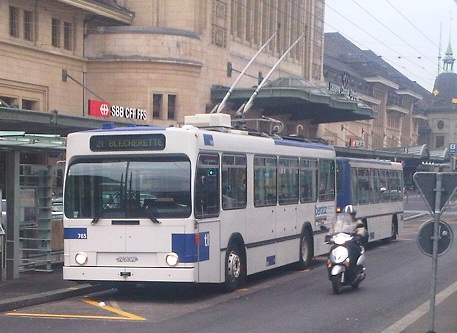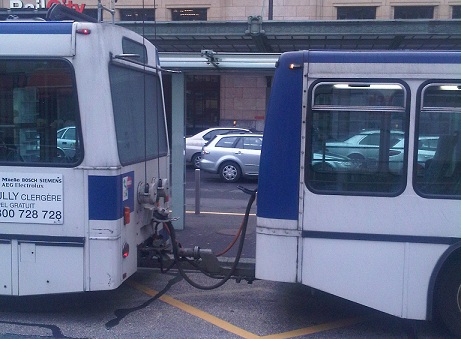However, while trolleybuses - both rigid and articulated - are still prevalent on the urban transport scene, one thing I noticed for the first time on this occasion was articuled trolleybuses where the trailer was completely separate from the main vehicle, with no opportunity for the passengers to walk through.
Here are two shots to illustrate what I mean...


I encountered these in Lausanne (as seen here) and also in Lucerne and very odd they look! I have no idea whether the driver has a way of seeing what's going on in the trailer - internal CCTV is no big deal these days, but the bus in this shot and many of the trailers look to be getting on in years, so I very much doubt they would have such features, so how could the driver know what was happening in the trailer? Or is this simply not seen as being a requirement?
My travelling companions and I also found ourselves wondering whether the trailers are semi-permanently coupled to the drawing vehicle, or whether they are separately allocated and attached on a daily basis. Our bus spotting skills and the length of our stay were not sufficient to enable us to see whether the same buses always appeared with the same trailer, but we certainly saw instances of buses with the relevant towing equipment operating without a trailer.
We had visions of Lausannois trolleybus drivers getting to the depot of a morning and complaining that their allocated trailer was parked at the back as always, or grumbling about particular trailers that they dislike!
If there are any knowledgeable Swiss transport buffs reading this, feel free to comment and advise!
Although the towing buses all seemed to be of the older types - a trawl of Wikipedia reveals that the bus in the above shots dates to between 1986 and 1990 - there was quite a wide range of trailers, from those appearing to be of very advanced years, right up to youthful low-floor examples. Indeed on a number of occasions, journeys advertised on the real-time information screens as being wheelchair accessible were fulfilled by an elderly step-entrance bus towing a modern low-floor trailer!
Just as an aside, the Swiss transport system is rightly revered in many ways. There is an obvious, logical hierarchy of services, with very efficient connections between them. Trains in particular are generally very comfortable and offer attractive frequencies, and everything runs very punctually.
However, one negative feature is that buses of the age shown in the above photos - equivalent to an E-, F-, or G-registered bus in the UK - are still running in very great quantities on main line routes on most Swiss urban networks. I can't think of a single major UK city where entire routes are still in the hands of similarly aged vehicles (there may be the odd exception, but nothing on the scale seen in Switzerland), and in many cases such networks are now one hundred per cent low-floor, so the British public transport system deserves some kudos for that!
Well having to climb Swiss Hills would make getting on an old high floor a slice of gateau.
ReplyDeleteAnd look at their economy: sound with old buses, and ours floundering with the latest SLFs
The trailers are intended to be uncoupled at quieter times of day, and, as far as I am aware, this potential is generally used. Some are being used in Germany with diesel buses (I believe with special dispensation) to cater for school time peak loads (for example, in a rural area in Hessen). There, the buses have been found to be slightly under-powered when working with a trailer, but more than adequate when working solo!
ReplyDeleteWith trolleybuses, there is a slight difference, in that they generally have much longer service lives than diesel buses (and the earlier Swiss manufactured diesel buses also seemed to be very durable). Thus the trolleybuses that you illustrate would probably not be regarded as particularly old, and no doubt have several years service life ahead of them. A trailer can more easily be built in a low-floor format than a powered unit, so it is possible that this approach has been chosen in order to be able to offer some form of low-floor provision. In that case, it is possible that the trailers are more permanently coupled. A similar approach has been used for trams in some cities, for example Darmstadt in Germany.